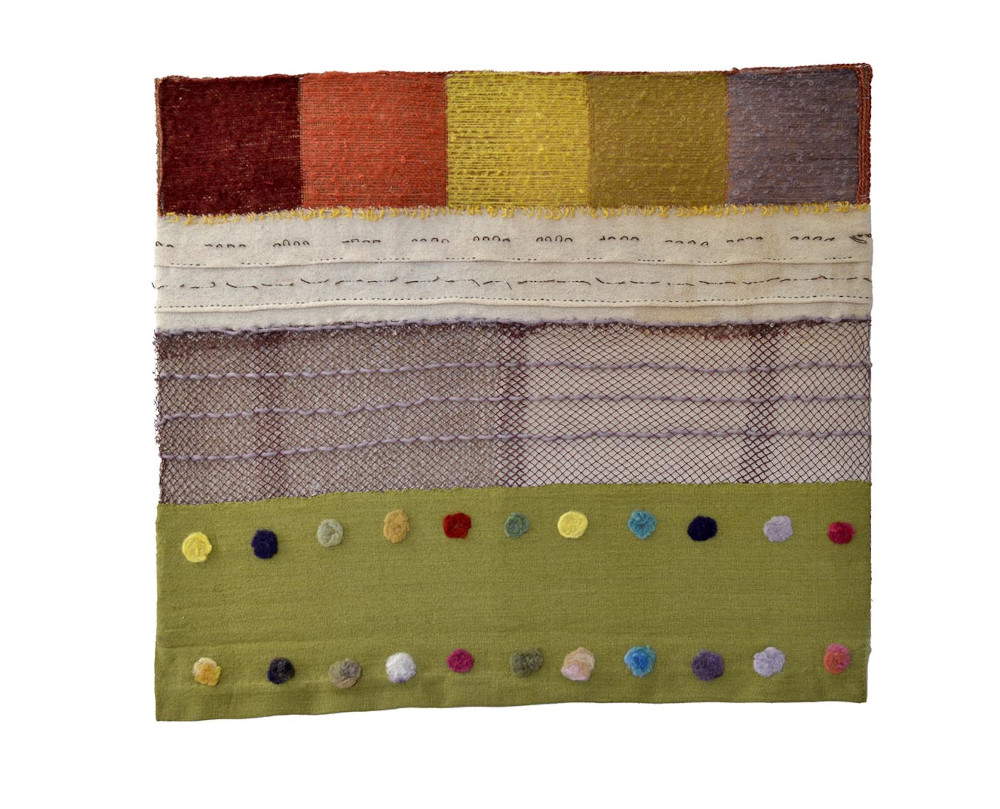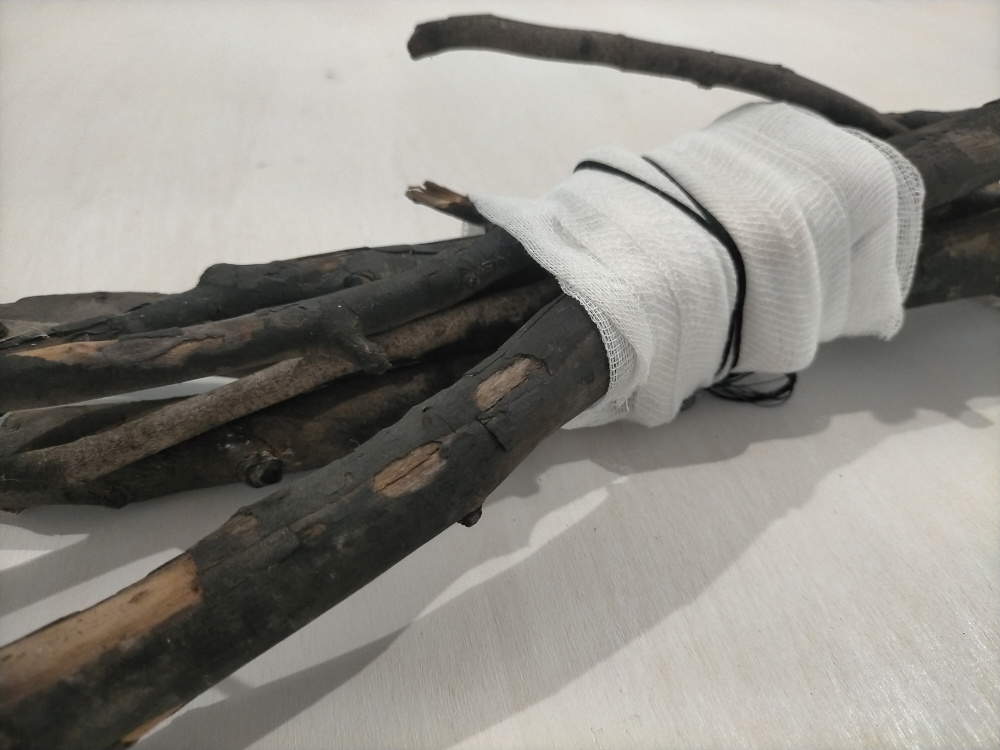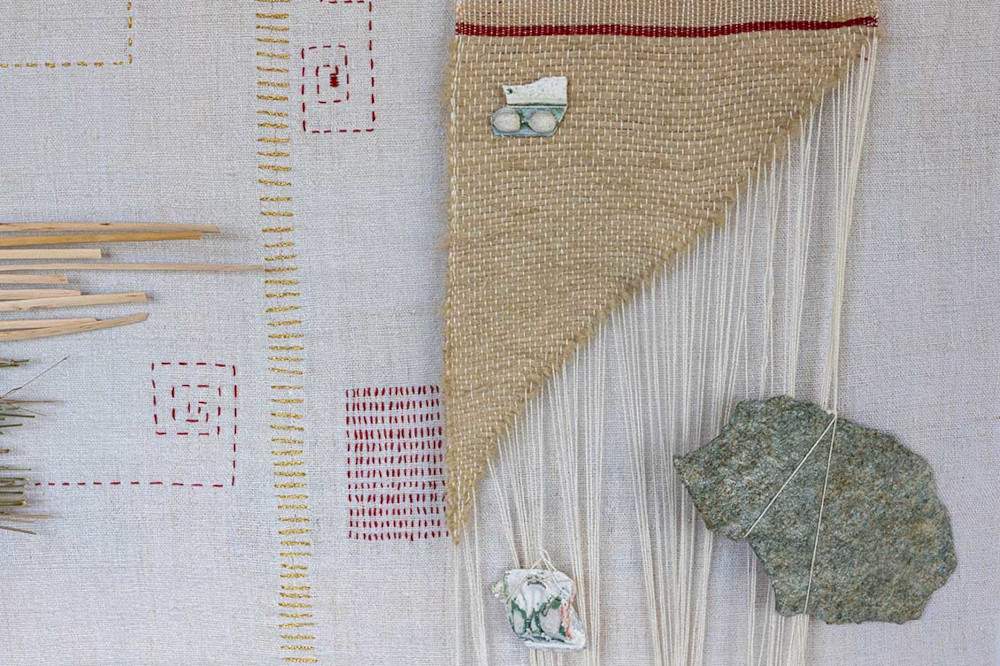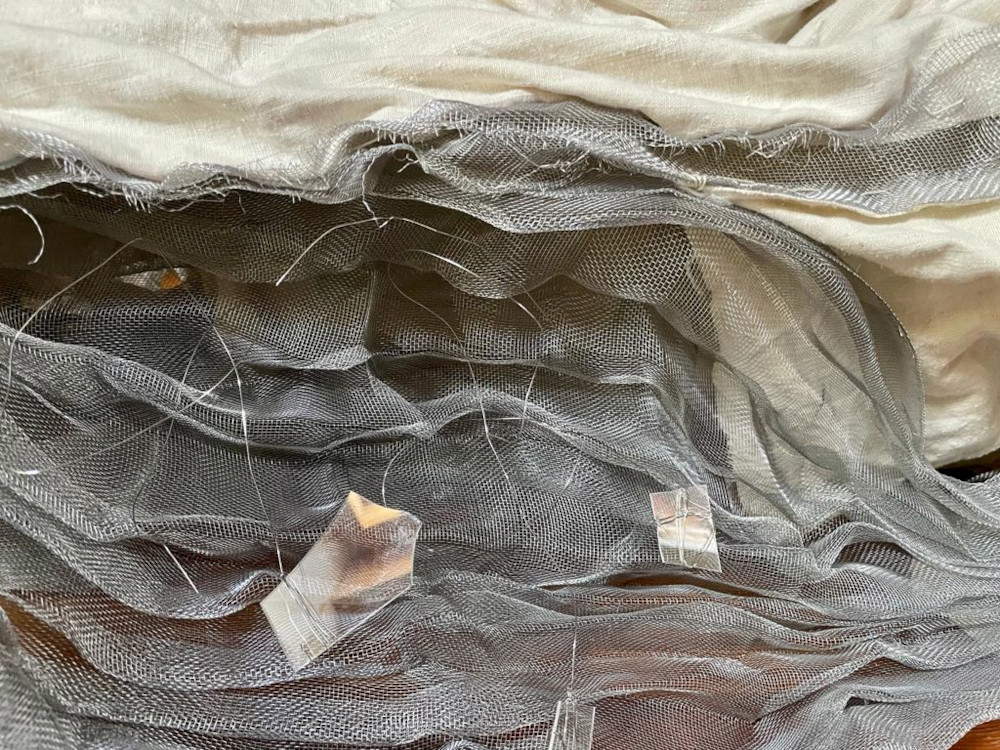After Mario Cresci returned to Valle d’Aosta at a distance of thirty years and the monographic exhibition dedicated to the Aostan artist Sarah Ledda, the exhibition year of Castello Gamba - Museum of Modern and Contemporary Art in Châtillon concludes with a group show of artists invited to question the theme of the environment, which is more topical today than ever, including that of Valle d’Aosta. Indeed, until February 4, 2024, the exhibition Environmental Rammends. Symbolic Reparations in Contemporary Art, curated by Gabriella Anedi, an art historian and gallery owner who has for years focused her work on Fiber Art and local textile traditions, and produced by ADART - Associazione Ambiente Design Arte.
For this exhibition, nine artists were invited to create works conceived as forms of reconstruction, of repair. As the curator explains, intent is to mend the environment, that is, the wounded space in which living beings live. Wall works, visual and sound installations intended “to guide the viewer to look with empathy at environmental imbalances that, while focused on particular situations identified in the Aosta Valley, can be read as models of universal alterations.” The artists were therefore asked to provide, according to their own vision, more than an interpretation of the phenomenon of man-made environmental disasters, a way for their possible reunion, a recomposition of the rupture that has been created between man and the environment, and to be reconnected with the contexts, creating a work that is not that of the project, but a visionary work that feeds on memory and desire. “We are not dealing here with ’environmental art,’ but with ’figures’ of a possible reconstruction that originate from a familiarity with a lived environment in which each author has seen the network of relationships between living beings collapse,” the curator points out. “Telling this rupture, prefiguring its repair, communicating with the symbolic language of art the personal and unique perception of this wound is the artists’ task.”
On display are all new and site-specific works made by mostly local artists, such as Romilda Boccia, Mariagiovanna Casagrande, Daniele de Giorgis (already present at Castello Gamba in the permanent collection), Chicco Margaroli (who donated the work Tapestry, 2016), Daniela Evangelisti and Piera Antonelli. However, artists from other regions are also participating, such as Emilia Persenico, Brenno Franceschi and Pietrina Atzori. The opening of the exhibition was followed by a performance by Gloria Campriani, who, accompanied by the music of Paolo Zampini, reconnected trees and men by weaving them with colored threads.The work created has become an integral part of the exhibition itinerary and will remain visible in the park surrounding Castello Gamba for the entire period of the exhibition.
The artists used multiple materials and dealt with various aspects of the environmental theme, from urban discontinuity to the rejection of aesthetic degradation, passing through flood disasters, fires and water emergency, to the dimension of human and animal habitation and the transformation of the landscape, always starting from reality. The starting point is a photograph, a map to mark, to show the violated place in its balances.
“What can art do? What can artists say? We ask them to be led on a path that, rather than strictly design, is visionary and nourished by memory and desire. These maps can then be modified and resignified in the design phase by all those energies, thoughts, memories that resurface in the gaze, in the body, in space,” comments the curator. “The exhibition thus documents each author’s journey, from the choice of the place to the stages that mark the progressive approach to the final work, a work that, in the autonomy of its poetics, is placed as a ’bridge’ between us, the artist and the world because it is charged with the emotions of a lived experience, of an affection that nourishes, in metaphorical form, the final goal: the composition of a new harmony. The artists are therefore asked to communicate an ethical consciousness and a symbolic planning, the foundational premises of any intervention on an asset that wants to be shared.”
The works in the exhibition are all linked by the formal element of the thread in the form of a bond, weave, knot, mending, suture, story.
Piera Antonelli’s work, scanned by chromatic and material areas, is configured as an “analogous” environment invented by uniting the desire for a harmony, somehow dreamed, but governed by formal rigor. This is the recomposition that the artist imagines for a small portion of territory on which he has seen, over the years, a succession of interventions and localized fractures that have compromised the environmental continuum. In his work, he seeks to build a new harmony between elements that have been separated and injured. In the damaged fabric, as in nature, it is difficult to reweave and here is a model of balanced construction where natural materials and dyes indulge the dream of feeling and reason.
Sardinian artist Pietrina Atzori has juxtaposed the landscape of Valle d’Aosta with that of Sardinia through the common practice of sheep farming. Going beyond the descriptive aspect, she sought the lowest common denominator of these places: by wrapping aluminum circles with wool, she created the image of the minimal constitutive unit of all living beings, the cell. In this “serene” presentation, however, the signs of destruction are inserted, such as the woods burned by fires that devastate areas less and less occupied by the daily care of the farmers, and wool once again becomes a metaphor for a saving possibility for all.
For Romilda Boccia, the environmental rupture takes the form of an arch, a doorway that, in the historic center of Aosta, connects the urban open space with the cloistered space of the ancient bishop’s palace. The tear produced by urban discontinuity and oblivion does not appear except in the memory of those who know how to reconstruct the wholeness of this portion of the wall: it is a network to recompose fragments of ancient embroidery as signs of a permanence in memory as opposed to the distracted haste of crossings that no longer leave traces.
It is on the theme of the transforming landscape that Mariagiovanna Casagrande ’s reflection focuses from her practice of architectural restoration of ancient artifacts characterizing the landscape of the Aosta Valley. With a methodology drawn from modern restoration theories, the artist weaves an imaginary “new” world, into which enter reversible, compatible and recognizable materials such as the original fragments of the fallen stuccoes of Saint Joseph’s church or old “lose” and stones from Valle d’Aosta that act as counterweights to new warps on which her landscape is stretched as a bridge between memory and new planning.




Daniele De Giorgis ’ restorative intervention stands as a path “à rebours” and, like a surgeon engaged in reopening sutures to free something that had been imprisoned, the artist seems to want to reopen that wound perhaps too hastily sewn up to let painful memory speak.
To the subdued and lost lament coming from the body of the glacier, Daniela Evangelisti responds by stretching out a blanket. Starting with photographic images of the terminal part of the Gran Etret, she creates a tactile and video-sound installation that materializes its current state of suffering. Listening to the groaning of nature and protecting its fragility, the artist becomes an interpreter of that maternal gesture which, addressed to every creature in a caring relationship, is transformed into an expression of shared ecological consciousness.
Brenno Franceschi starts from the human dwelling dimension, as fragile as an old fabric whose wefts and tears he has highlighted and which, progressively, has come to resemble those of nature in its dynamics. It was a larch bark that appeared to him as an image of this common becoming. The principle of transformation and adaptation among different species of living things is linked to these almost transparent little houses, permeable to the environment, fragile but interdependent as they hang from pulleys: a model of an interconnected environment.
In his installation, Chicco Margaroli was guided by the theme of water, starting from a water emergency analyzed in the Conca di By, Ollomont, precisely at the foot of the great snowfield close to the Valsorey glacier: the retreat and leakage of the spring, which ensured water supply to the high pastures of the alpine pasture, caused such a water shortage in 2022 that the herds suffered a severe abortion rate. An engineering mending was put in place by means of a skein of pipes transported by a helicopter that, in a 1,000-meter journey, was able to reconnect the spring to the high pasture. This life-preserving water reservoir theme was elaborated by the artist, with a shift from the technological to the symbolic plane: this is how stabilized calf bladders come to be arranged as a lattice-like aggregation of H2O molecules, a light suspension that invites a re-reading of the delicate mechanisms of interaction between man nature and the environment.
Against the habituation to aesthetic degradation, Emilia Persenico intervened with a kind of temporal x-ray, made of overlapping layers. An aesthetic empathy that allowed her to imagine new blooms with transparent stratifications, almost an archaeological excavation: restarting from an original but now endangered flora and fauna becomes the condition to prefigure a new life for these environments.




For all info you can visit www.castellogamba.vda.it
Hours: Tuesday through Sunday 10 a.m. to 5 p.m. Closed Mondays.
 |
| How can the environment be mended? At Gamba Castle, a group exhibition reflects on the topic |
Warning: the translation into English of the original Italian article was created using automatic tools. We undertake to review all articles, but we do not guarantee the total absence of inaccuracies in the translation due to the program. You can find the original by clicking on the ITA button. If you find any mistake,please contact us.